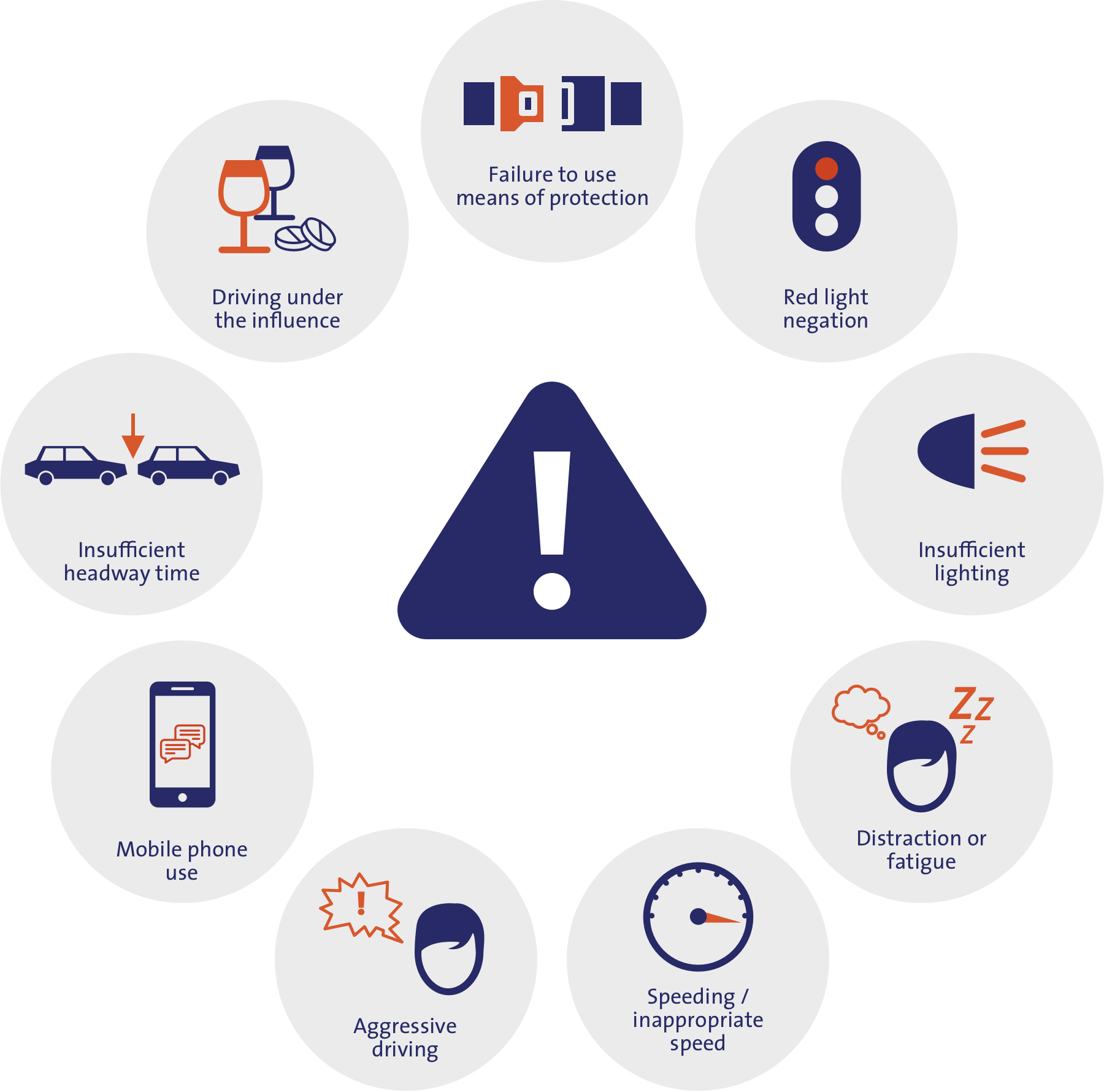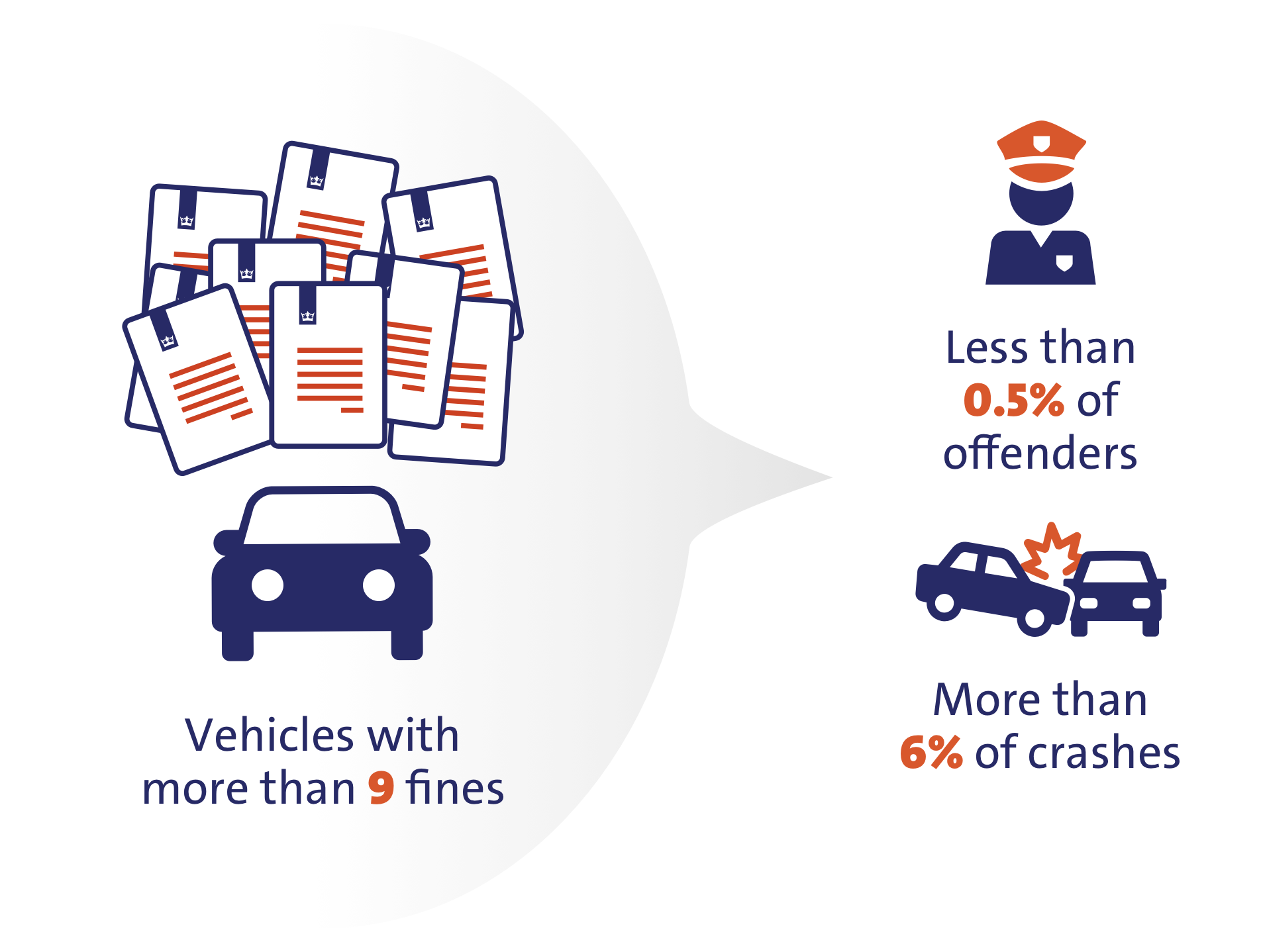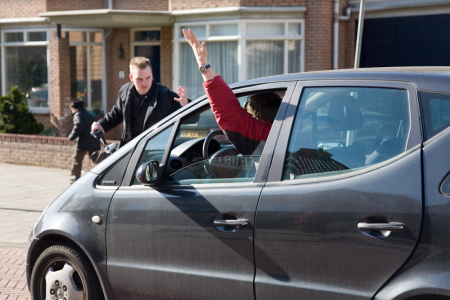Below you will find the list of references that are used in this fact sheet. All sources used can be consulted or retrieved via our Library portal. Here you can also find more literature on this subject.
[1]. Weijermars, W.A.M., Stipdonk, H.L., Aarts, L.T., Bos, N.M., et al. (2014). Verkeersveiligheidsbalans 2000-2012. Oorzaken en gevolgen van verkeersonveiligheid [Road safety assessment 2000-2012. Causes and consequences of road unsafety]. R-2014-24.[Summary in English]. SWOV, Den Haag.
[2]. Zhang, T. & Chan, A.H.S. (2016). The association between driving anger and driving outcomes: A meta-analysis of evidence from the past twenty years. In: Accident Analysis & Prevention, vol. 90, p. 50-62.
[3]. Dula, C.S. & Geller, E.S. (2003). Risky, aggressive, or emotional driving: Addressing the need for consistent communication in research. In: Journal of Safety Research, vol. 34, nr. 5, p. 559-566.
4]. Craig-Henderson, K.M. (2006). Road rage: When drivers lose it. In: PsycCRITIQUES, vol. 51, nr. 8.
[5]. Tasca, L. (2000). A review of the literature on aggressive driving research. Paper presented at the Aggressive Driving Issues Conference, October 16th to November 30th, 2000, Downsview, Ontario.
[6]. Levelt, P.B.M. (1997). Agressief gedrag in het verkeer. Opvattingen, stand van zaken en aanbevelingen [Aggressive behaviour in traffic]. R-97-45. [Summary in English]. SWOV, Leidschendam.
[7]. Mesken, J. (2006). Determinants and consequences of drivers' emotions. PhD-thesis Rijksuniversiteit Groningen RUG, SWOV-Dissertatiereeks. SWOV, Leidschendam.
[8]. Deffenbacher, J.L. (2016). A review of interventions for the reduction of driving anger. In: Transportation Research Part F: Traffic Psychology and Behaviour, vol. 42, p. 411-421.
[9]. Lorsheijd, J. (2019). Bumperkleven grootste ergernis in het verkeer. Verkeerskunde. Accessed on 04-09-2020 at www.verkeerskunde.nl/artikel/bumperkleven-grootste-ergernis-in-het-verkeer.
[10]. Greven, J. & Bosveld, W. (2013). Fietsergernissen. Omnibus 91. Gemeente Amsterdam, Bureau Onderzoek en Statistiek Amsterdam.
[11]. Deffenbacher, J.L., Stephens, A.N. & Sullman, M.J.M. (2016). Driving anger as a psychological construct: Twenty years of research using the Driving Anger Scale. In: Transportation Research Part F: Traffic Psychology and Behaviour, vol. 42, p. 236-247.
[12]. Deffenbacher, J.L., Deffenbacher, D.M., Lynch, R.S. & Richards, T.L. (2003). Anger, aggression, and risky behavior: a comparison of high and low anger drivers. In: Behaviour Research and Therapy, vol. 41, nr. 6, p. 701-718.
[13]. Nesbit, S.M., Conger, J.C. & Conger, A.J. (2007). A quantitative review of the relationship between anger and aggressive driving. In: Aggression and Violent Behavior, vol. 12, nr. 2, p. 156-176.
[14]. Ellison, P.A., Govern, J.M., Petri, H.L. & Figler, M.H. (1995). Anonymity and aggressive driving behavior: A field study. In: Journal of Social Behavior & Personality, vol. 10, nr. 1, p. 265-272.
[15]. Ellison-Potter, P., Bell, P. & Deffenbacher, J. (2001). The effects of trait driving anger, anonymity, and aggressive stimuli on aggressive driving behavior. In: Journal of Applied Social Psychology, vol. 31, nr. 2, p. 431-443.
[16]. Stephens, A.N., O’Hern, S., Trawley, S., Young, K.L., et al. (2019). Self-reported aggression amongst active cyclists. In: Accident Analysis & Prevention, vol. 128, p. 46-52.
[17]. CBS (2020). Veiligheidsmonitor 2019. Centraal Bureau voor de Statistiek CBS, Den Haag.
[18]. Kester, J. (2019). Onderzoek: Verkeersruzies. 1V OpiniePanel Rapport. EenVandaag.
[19]. Dagblad van het Noorden (2019). Weggebruikers ergeren zich kapot aan elkaar; hufterigheid neemt ook toe. Accessed on 04-09-2020 at www.dvhn.nl/extra/Weggebruikers-ergeren-zich-kapot-aan-elkaar-hufterigheid-neemt-ook-toe-24709999.html?harvest_referrer=https%3A%2F%2Ftoestemming.ndcmediagroep.nl%2F%3Ftoken%3Dc8ffaf7a-acdb-4a06-bb14-53ff2269daf4.
[20]. Dikke van Dale (2015). Van Dale Uitgevers, Utrecht.
[21]. Bieleman, B., Boendermaker, M., Mennes, R. & Snippe, J. (2014). Hard op weg. Onderzoek naar verkeersveelplegers. Politiekunde 65, Politie en Wetenschap. Reed Business, Amsterdam, Apeldoorn.
[22]. Goldenbeld, C. & Twisk, D.A.M. (2009). Verkeersovertredingen, veelplegers en verkeersonveiligheid. Kennis uit bestaand onderzoek [Traffic offences, multiple offenders and road safety. Knowledge from existing research]. R-2009-7 [Summary in English]. SWOV, Leidschendam.
[23]. Rijksoverheid (2016). Richtlijn voor strafvordering feitgecodeerde misdrijven en overtredingen 2016. Accessed on 17-11-2020 at wetten.overheid.nl/BWBR0037399/2016-01-01.
[24]. OM (2016). Veelplegers in het verkeer. Openbaar Ministerie. Accessed on 19-10-2020 at www.om.nl/onderwerpen/verkeer/handhaving/veelplegers-in-het-verkeer.
[25]. Minister van VenJ (2014). Brief Tweede kamer Stand van zaken aanpak veelplegers in het verkeer. Kamerbrief. Ministerie van Veiligheid en Justitie, Den Haag.
[26]. Goldenbeld, C., Reurings, M.C.B., Norden, Y. van & Stipdonk, H.L. (2011). Relatie tussen verkeersovertredingen en verkeersongevallen. Verkennend onderzoek op basis van CJIB-gegevens [The relation between traffic offences and road crashes. Preliminary study making use of Central Fine Collection Agency (CJIB) data]. R-2011-19 [Summary in English]. SWOV, Leidschendam.
[27]. NHTSA (2019). Distracted driving in fatal crashes, 2017. National Highway Traffic Safety Administration NHTSA, Washington, D.C.
[28]. Aarts, L.T., Loenis, B., Korving, H. & Guiking, C. (2017). Risicofactoren op 50km/uur-kruispunten met verkeerslichten. Methodologische verdieping en verdere verkenning van de kwantificering van risicofactoren zoals roodlichtnegatie [Risk factors at 50 km/h intersections with traffic lights. Methodological follow-up and further exploration of the quantification of risk factors such as red light runningrunning]. R-2017-21 [Summary in English]. SWOV, Den Haag.
[29]. Kuiken, M. & Stoop, J. (2012). Verbetering van fietsverlichting. Verkenning van beleidsmogelijkheden. Ministerie van Infrastructuur en Milieu (IenM), Directoraat-Generaal Rijkswaterstaat, Dienst Verkeer en Scheepvaart DVS, Delft.
[30]. AAA Foundation (2009). Aggressive Driving: Research Update. AAA Foundation for Traffic Safety, Washington.
[31]. Goldenbeld, C. & Buttler, I. (2019). Enforcement and traffic violations. ESRA2 Thematic report Nr. 6 - E-Survey of Road users’ Attitudes. SWOV, Den Haag.
[32]. Kint, S.T. van der & Mons, C. (2019). Interpolis Barometer 2019. Vragenlijststudie mobiel telefoongebruik in het verkeer [Interpolis Barometer 2019. Questionnaire study mobile phone use in traffic]. R-2019-26 [Summary in English]. SWOV, Den Haag.
[33]. Houwing, S., Twisk, D.A.M. & Waard, D. de (2015). Alcoholgebruik van jongeren in het verkeer op stapavonden. R-2015-12. SWOV, Den Haag.
[34]. Tajfel, H. & Turner, J.C. (1986). The social identity theory of intergroup behavior. In: Worchel, S. & Austin, W. (red.), Psychology of intergroup relations. Nelson-Hall, Chicago, p. 7-24.
[35]. Hoekstra, A.T.G., Twisk, D.A.M. & Hagenzieker, M.P. (2018). Do road user roles serve as social identities? Differences between self-described cyclists and car drivers. In: Transportation Research Part F: Traffic Psychology and Behaviour, vol. 59, p. 365-377.
[36]. Goldenbeld, C. & Mesken, J. (2012). Verkeersovertreders, achtergronden van gedrag en mogelijkheden voor beïnvloeding door voorlichting. Een literatuurstudie [Traffic offenders, backgrounds to behaviour and options for intervention through education. A literature study]. R-2012-15 [Summary in English]. SWOV, Leidschendam.
[37]. Mesken, J., Hagenzieker, M.P. & Rothengatter, J.A. (2008). A review of studies on emotions and road user behaviour. In: Dorn, L. (red.), Driver behaviour and training Vol III; Human factors in road and rail transport; based on the contributions for the Third International Conference on Driver Behaviour and Training. 12-13 November 2007. Ashgate, Aldershot, Dublin.
[38]. Rhodes, N. & Pivik, K. (2011). Age and gender differences in risky driving: The roles of positive affect and risk perception. In: Accident Analysis & Prevention, vol. 43, nr. 3, p. 923-931.
[39]. González-Iglesias, B., Gómez-Fraguela, J.A. & Luengo-Martín, M.Á. (2012). Driving anger and traffic violations: Gender differences. In: Transportation Research Part F: Traffic Psychology and Behaviour, vol. 15, nr. 4, p. 404-412.
[40]. Ball, L., Tully, R. & Egan, V. (2018). The influence of impulsivity and the Dark Triad on self-reported aggressive driving behaviours. In: Accident Analysis & Prevention, vol. 120, p. 130-138.
[41]. Bushman, B.J., Steffgen, G., Kerwin, T., Whitlock, T., et al. (2018). “Don’t you know I own the road?” The link between narcissism and aggressive driving. In: Transportation Research Part F: Traffic Psychology and Behaviour, vol. 52, p. 14-20.
[42]. Meunier, J.-C., Schinckus, L. & Kaiser, S. (2019). Themadossier Verkeersveiligheid nr. 20 – Risicobereidheid en agressie. Vias institute – Kenniscentrum Verkeersveiligheid, Brussel.
[43]. Bowen, L., Budden, S.L. & Smith, A.P. (2020). Factors underpinning unsafe driving: A systematic literature review of car drivers. In: Transportation Research Part F: Traffic Psychology and Behaviour, vol. 72, p. 184-210.
[44]. Goldenbeld, C. & Schagen, I. van (2016). Personal Factors – Sensation Seeking. European Road Safety Decision Support System, developed by the H2020 project SafetyCube. Accessed on 18-09-2018 at www.roadsafety-dss.eu.
[45]. Dahlen, E.R., Edwards, B.D., Tubré, T., Zyphur, M.J., et al. (2012). Taking a look behind the wheel: An investigation into the personality predictors of aggressive driving. In: Accident Analysis & Prevention, vol. 45, p. 1-9.
[46]. Goldenbeld, C., Torfs, K., Vlakveld, W. & Houwing, S. (2020). Impaired driving due to alcohol or drugs. International differences and determinants based on E-Survey of Road Users' Attitudes first-wave results in 32 countries. In: IATSS Research.
[47]. Goldenbeld, C., Blom, M. & Houwing, S. (2016). Zware alcoholovertreders in het verkeer. Omvang van het probleem en kenmerken van de overtreders [Serious alcohol offenders in traffic. Extent of the problem and characteristics of the offenders]. R-2016-12 [Summary in English]. SWOV, Den Haag.
[48]. Martí-Belda Bertolín, A., Pastor Soriano, J.C., Montoro González, L., Bosó Seguí, P., et al. (2019). Persistent traffic offenders. Alcohol consumption and personality as predictors of driving disqualification. In: The European Journal of Psychology Applied to Legal Context, 2019, vol. 11, nr. 2, p. 81-92.
[49]. Blom, M., Boschman, S.E. & Weijters, G. (2022). Differentiële effectiviteit maatregelen alcohol en verkeer. Cahier 2022-7. Wetenschappelijk Onderzoek- en documentatie Centrum WODC, Den Haag.
[50]. Blom, M., Blokdijk, D. & Weijters, G. (2017). Recidive na een educatieve maatregel voor verkeersovertreders of tijdens een Alcoholslotprogramma. Cahier 2017-15. Wetenschappelijk Onderzoek- en Documentatiecentrum WODC, Den Haag.
[51]. Blom, M., Blokdijk, D. & Weijters, G. (2019). Recidive na maatregelen rijvaardigheid en geschiktheid. Cahier 2019-20. Wetenschappelijk Onderzoek- en Documentatiecentrum WODC, Den Haag.
[52]. SUPREME (2007). Thematic report: Rehabilitation and diagnostics. Directorate-General for Transport and Energy (TREN), European Commission, Brussels.
[53]. Bjerre, B. & Thorsson, U. (2008). Is an alcohol ignition interlock programme a useful tool for changing the alcohol and driving habits of drink-drivers? In: Accident Analysis & Prevention, vol. 40, nr. 1, p. 267-273.
[54]. Gustafsson, S. & Forsman, A. (2016). Utvärdering av alkolås efter rattfylleri: enkätstudie [Evaluation of a Swedish alcohol interlock program for drink driving offenders: questionnaire study]. VTI-code: 35-2016; summary in English. VTI, Linköping.
[55]. Castillo-Manzano, J.I. & Castro-Nuño, M. (2012). Driving licenses based on points systems: Efficient road safety strategy or latest fashion in global transport policy? A worldwide meta-analysis. In: Transport Policy, vol. 21, p. 191-201.
[56]. Hoekstra, A.T.G., Eenink, R.G. & Goldenbeld, C. (2017). Progressief boetestelsel en verkeersveiligheid. Geschatte veiligheidseffecten van hogere boetes bij herhaalde snelheidsovertredingen [Progressive penalty system and road safety. Estimated safety effects of progressive fines for repeated speeding offences]. R-2017-3 [Summary in English]. SWOV, Den Haag.
[57]. Bolderdijk, J.W., Knockaert, J., Steg, E.M. & Verhoef, E.T. (2011). Effects of Pay-As-You-Drive vehicle insurance on young drivers’ speed choice: Results of a Dutch field experiment. In: Accident Analysis & Prevention, vol. 43, nr. 3, p. 1181-1186.
[58]. Dijksterhuis, C., Lewis-Evans, B., Jelijs, B., Waard, D. de, et al. (2015). The impact of immediate or delayed feedback on driving behaviour in a simulated Pay-As-You-Drive system. In: Accident Analysis & Prevention, vol. 75, p. 93-104.
[59]. Vlakveld, W. (2018). Notitie Monitor- en Feedbacksystemen. Literatuurstudie naar de effecten van monitor- en feedbacksystemen op het rijgedrag. R-2018-26. SWOV, Den Haag.
[60]. Neighbors, C., Vietor, N.A. & Knee, C.R. (2002). A motivational model of driving anger and aggression. In: Personality and Social Psychology Bulletin, vol. 28, nr. 3, p. 324-335.
[61]. Gemeente Amsterdam (2018). Verkeersbesluit Snorfiets naar de rijbaan met helmplicht te Amsterdam. In: Staatscourant van het Koninkrijk der Nederlanden, vol. Staatscourant 2018, 71559.
[62]. Stanojević, P., Sullman, M.J.M., Jovanović, D. & Stanojević, D. (2018). The impact of police presence on angry and aggressive driving. In: Accident Analysis & Prevention, vol. 110, p. 93-100.
[63]. Hoekstra, A.T.G. (2020). De effectiviteit van maatregelen op veelplegers in het verkeer; Een literatuurstudie [The effectiveness of measures targeting repeat traffic offenders; a literature review]. R-2020-9 [Summary in English]. SWOV, Den Haag.
[64]. Kuiken, M., Barten, M. & Fokkema, J. (2009). Aanpak van notoire Verkeersovertreders. Een verkenning. Directoraat-Generaal Rijkswaterstaat, Dienst Verkeer en Scheepvaart DVS, Delft.



